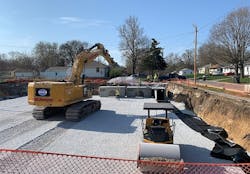The Highland Park neighborhood in Des Moines, IA, has had a long history of flooding issues due to urban development and its undersized sewer built in the 1930s. The drainage system provides only a portion of the sewer capacity needed to meet today’s design standards. Parts of the neighborhood are also considered special flood hazard areas by FEMA (Federal Emergency Management Agency), which means homeowners must purchase supplemental flood insurance in addition to their regular home insurance. After many years of planning, drainage studies, and input from residents and businesses, the City of Des Moines began implementing the Hamilton Drain Stormwater Improvements project, consisting of multiple phases. It involves removing and replacing an old wooden box culvert with new storm sewers and additional green solutions to mitigate flooding events.
The construction of Phase 1 started in Spring 2021. It included two main stormwater improvements: constructing a small above-ground detention basin near E 12th Street and E Oak Park Ave and installing two underground stormwater vaults under a church's parking lots at the intersection of E Shawnee Ave and Amherst St. The objective was to reduce peak flows downstream by locally providing a large storage volume and improving water quality with infiltration techniques.
StormTrap worked with the City of Des Moines and consultant Kirkham Michael to design a system that met the project goals. Two 5’-8” SingleTrap vaults built with 78 modular pieces each, were selected to provide stormwater detention and infiltration. A 10’ Downstream Defender® pretreatment unit, supplied by StormTrap and produced by Hydro International, was also chosen to remove trash, floatables, and larger sediment at the primary inlet pipe that brings in water from 18 acres of the neighborhood.
Stormwater pretreated in the Downstream Defender is discharged to one of the underground detention basins, built with an internal sediment row designed to provide additional sediment capture before infiltrating into the ground. Another pipe connects both vaults, and they collectively provide over 110,000 cf, which meets the volume requirement for the project. Most of the water entering the vaults infiltrates before allowing water to bypass into the downstream system.
This system was the perfect solution for the site, “the StormTrap basins allowed for a much smaller footprint with a significant advantage in-depth and storage volume compared to plastic arch basin systems. This allowed us to stay away from adjacent property owners and still provide the volume and treatment desired,” affirmed Scott Almeida, Vice President at Kirkham Michael.
S M Hentges installed the two basins and the hydrodynamic separator in four days. The system will be maintained by the City and will be inspected quarterly and after each significant rain event for the first few years to establish levels of debris and/ or sediment within the system and future maintenance schedule.
With this project, the City of Des Moines has gained some much-needed stormwater storage, the neighboring church received two new parking lots, and the residents don’t need to fear basement or roadway flooding.
Editor's Note: Scranton Gillette Communications and the SGC Water Group are not liable for the accuracy, efficacy and validity of the claims made in this piece. The views expressed in this content do not reflect the position of the editorial teams of Water & Wastes Digest, Water Quality Products and Storm Water Solutions.







